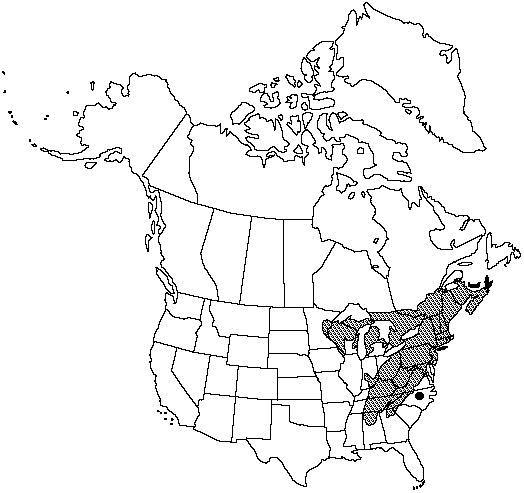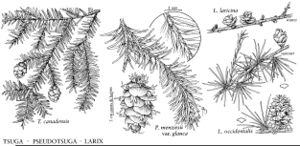Difference between revisions of "Tsuga canadensis"
189. 1855.
FNA>Volume Importer |
FNA>Volume Importer |
(No difference)
| |
Revision as of 18:57, 24 September 2019
Trees to 30m; trunk to 1.5m diam.; crown broadly conic. Bark brownish, scaly and fissured. Twigs yellow-brown, densely pubescent. Buds ovoid, 1.5–2.5mm. Leaves (5–)15–20(–25)mm, mostly appearing 2-ranked, flattened; abaxial surface glaucous, with 2 broad, conspicuous stomatal bands, adaxial surface shiny green (yellow-green); margins minutely dentate, especially toward apex. Seed cones ovoid, 1.5–2.5 × 1–1.5cm; scales ovate to cuneate, 8–12 × 7–10mm, apex ± round, often projected outward. 2n =24.
Habitat: Moist rocky ridges, ravines, and hillsides
Elevation: 600–1800m
Distribution

N.B., N.S., Ont., P.E.I., Que., Ala., Conn., Del., Ga., Ind., Ky., Maine, Md., Mass., Mich., Minn., N.H., N.J., N.Y., N.C., Ohio, Pa., R.I., S.C., Tenn., Vt., Va., W.Va., Wis.
Discussion
Numerous cultivars of Tsuga canadensis have been developed, including compact shrubs, dwarfs, and graceful trees. Wood of the species tends to be brittle and inferior to that of the other North American hemlocks.
Eastern hemlock (Tsuga canadensis) is the state tree of Pennsylvania.
Selected References
None.
